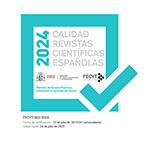The construction of female crime in the plots of media criminology
Abstract
Introduction. The article asks about the ways in which journalistic discourse re-articulates criminological typologies and mechanisms of stigmatization- criminalization of certain femininities. Objective. For this purpose, it describes and analyses the media construction of women, cis and trans, who have incurred in criminal acts, or outlawed. Methodology. The study, based on ten news items from digital graphic media in Argentina, is developed from a qualitative methodological perspective, using variables and procedures from Discourse Analysis (DA), for the identification and interpretation of discursive marks and gendered social meanings. Results. As for cis women, it is reconfirmed the historical relationship of eccentricity between the feminine and the universe of crime; it is reinforce the criminological stereotype of a woman that is settled between her pathological and vampiresque figuration. As for trans and transvestite women, there is a dehumanized treatment that places them in ontological sites of marginality and infringement. Conclusions and discussion. Despite the normative, cultural and social advances promoted by feminism, journalism remains a widely legitimized space for the deployment of symbolic violence, as there are condensed and produced sexist, xenophobic and racist representations, but also an idea of gender based on the biological that has a differential impact on bodies and on the violence they may suffer. Contribution. The research complicates the thematic articulation of media/gender/women by posing the counter-face of the woman narrated as subject-victim and moving to “the victimizers”, but it also represents an epistemological expansion by proposing a transdisciplinary approach that draws on feminist criminological theories and Cultural Studies on media.
Downloads
Article download
License
In order to support the global exchange of knowledge, the journal Investigaciones Feministas is allowing unrestricted access to its content as from its publication in this electronic edition, and as such it is an open-access journal. The originals published in this journal are the property of the Complutense University of Madrid and any reproduction thereof in full or in part must cite the source. All content is distributed under a Creative Commons Attribution 4.0 use and distribution licence (CC BY 4.0). This circumstance must be expressly stated in these terms where necessary. You can view the summary and the complete legal text of the licence.











